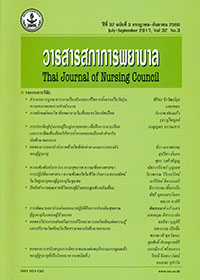ผลของการออกกำลังกายด้วยไทชิต่อท่าทางและการทรงตัวของผู้สูงอายุ
คำสำคัญ:
ผู้สูงอายุ, ท่าทาง, การทรงตัว, ควา, ยืดหยุ่นของร่างกาย, การออกกำลังกายด้วยไทชิบทคัดย่อ
วัตถุประสงค์ของการวิจัย: เพื่อศึกษาระยะเวลาในการออกกำลังกายด้วยไทชิที่มีผล
ต่อการเปลี่ยนแปลงท่าทางและการทรงตัวของผู้สูงอายุ
การออกแบบการวิจัย: การวิจัยกึ่งทดลองแบบกลุ่มเดียววัดซ้ำ
การดำเนินการวิจัย:กลุ่มตัวอย่างเป็นผู้สูงอายุที่อาศัยในบ้านพักผู้สูงอายุและมีคุณสมบัติ
ตามเกณฑ์ที่กำหนด จำนวน 30 ราย เข้าร่วมกิจกรรมการออกกำลังกายด้วยไทชิ ครั้งละ 60 นาที
สัปดาห์ละ 3 ครั้ง เป็นระยะเวลา 12 สัปดาห์ เก็บรวบรวมข้อมูลโดยบันทึกข้อมูลทั่วไปของ
ผู้สูงอายุ ข้อมูลท่าทางของร่างกาย ได้แก่ ท่าทางของร่างกายขณะอยู่กับที่ และความยืดหยุ่น
ของร่างกาย และข้อมูลการทรงตัว ได้แก่ การทรงตัวขณะอยู่กับที่ และการทรงตัวขณะเคลื่อนที่
วิเคราะห์ข้อมูลทั่วไปด้วยสถิติบรรยาย เปรียบเทียบความแตกต่างของท่าทางและการทรงตัว
ของผู้สูงอายุ ด้วยการวิเคราะห์ความแปรปรวนแบบวัดซ้ำ
ผลการวิจัย: หลังการทดลองค่าเฉลี่ยของท่าทางขณะอยู่กับที่ของผู้สูงอายุไม่มีเปลี่ยนแปลง
ขณะที่ค่าเฉลี่ยของความยืดหยุ่นของร่างกายในสัปดาห์ที่ 4 สูงกว่าก่อนออกกำลังกายด้วยไทชิ
และสูงขึ้นในสัปดาห์ที่ 8 และสัปดาห์ที่ 12 อย่างมีนัยสำคัญทางสถิติที่ระดับ .05 สำหรับ
ค่าเฉลี่ยของการทรงตัวขณะเคลื่อนที่ในสัปดาห์ที่ 8 สูงกว่าก่อนออกกำลังกายด้วยไทชิและสูงขึ้น
ในสัปดาห์ที่ 12 อย่างมีนัยสำคัญทางสถิติที่ระดับ .05 และการทรงตัวขณะอยู่กับที่ในสัปดาห์ที่ 4
มีค่าเฉลี่ยสูงกว่าก่อนออกกำลังกายด้วยไทชิและสูงขึ้นในสัปดาห์ที่ 8 และสัปดาห์ที่ 12 อย่าง
มีนัยสำคัญทางสถิติที่ระดับ .05
ข้อเสนอแนะ: การออกกำลังกายด้วยไทชิเพื่อให้ผู้สูงอายุมีความยืดหยุ่นของร่างกาย
และมีการทรงตัวขณะอยู่กับที่ดีขึ้น ใช้เวลาอย่างน้อย 4 สัปดาห์ และการออกกำลังกายด้วยไทชิ
เพื่อให้ผู้สูงอายุมีการทรงตัวขณะเคลื่อนที่ดีขึ้น ใช้เวลาอย่างน้อย 8 สัปดาห์
Downloads
เอกสารอ้างอิง
[cited 2016 November 13] Available from: http://www.ipsr.mahidol.ac.th/ipsr/Contents/Documents/
Gazette/Population_Gazette2015-TH.pdf.(In Thai)
2. World Health Organization. Global Health and Aging [Internet] 2011 [cited 2017 March 6] Available from:
http://www.who.int/ageing/publications/global_health.pdf
3. Berg, KO, Wood-Dauphinee, SL, Williams, JI,Gay-ton, D. Measuring balance in elderly: preliminary
development of an instrument. Physiotherapy Canada 1989; 41, 304-11.
4. Nelson, ME, Rejeski, WJ, Blair, SN, Duncan, PW, Judge, JO, King, AC. American Heart Association. Physical
activity and public health in older adults: recommendation from the American College of Sports Medicine and
the American Heart Association. Circulation 2007;116(9):1094–105.
5. Kulsatitporn, S. Physical therapy in older adults.2nd ed. Bangkok: Offset Press; 2006. (In Thai)
6. Lan, C., S.Y. Chen, and J.S. Lai, The exercise intensity of Tai Chi Chuan. Med Sport Sci 2008; 52, 12-9.
7. Gyllensten, AL, Hui-Chan, CWY, Tsang, WWN.Stability limits, single-leg jump, and body awareness
in older Tai Chi practitioners. Arch Phys Med Rehabil 2010; 91, 215-20.
8. Dustitsin, N. Qigong for older adults. In Department of Thai Traditional and Alternative Medicine, Comprehensive
Health Care for Older Adults (pp. 153-178). Nonthaburi: Department of Thai Traditional and Alternative
Medicine; 2010. (In Thai)
9. Blake, H, Hawley, H. Effects of Tai Chi exercise on physical and psychological health of older people. Curr
Aging Sci 2012; 5(1), 19-27.
10. Maciaszek, J, Osi´nski, W. The effects of Tai Chi on body balance in elderly people - a review of studies
from the early 21st century. Am J Chin Med 2010; 38(2), 219-29.
11. Buchner, A, Erdfelder, E, Faul, F, Lang, A-G. G*Power: statistical power analyses for windows and mac.
[Internet] 2016 [cited 2016 May 9] Available from: http://www.psycho. uni-duesseldorf.de/abteilungen/
aap/gpower3/
12. Manmai, P. Effects of Tai-Chi exercise on balance control and neuropsycho physiological performance
in elderly practitioners. (Master of Sciences). Bangkok: Mahidol University; 2005. (In Thai)
13. Srisa-ard, B. Basic concepts in research methodology.2nd ed. Bangkok; Suriyasan Publishers; 1992. (In Thai)
14. Jitapunkul, S. Principles of geriatric medicine. 3rd ed.Bangkok; Chulalongkorn university press; 2001.
(In Thai)
15. Earnarumitt, T. Basic concepts of Qigong. In Theim Earnarumitt (Ed), Qigong for health (pp.153-178).
Bangkok: Department of health; 2001. (In Thai)
16. Shumway-Cook, A, Brauer, S, Woollacott, MH.Predicting the probability for falls in community
dwelling older adults using the timed up & go test.Phys Ther 2000; 80, 896-903.








